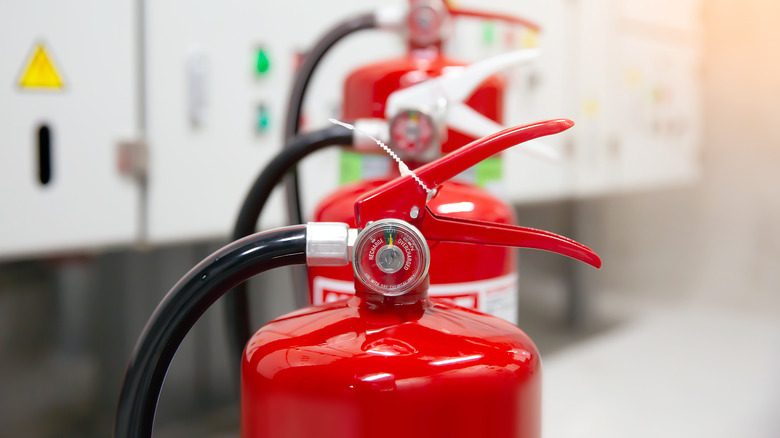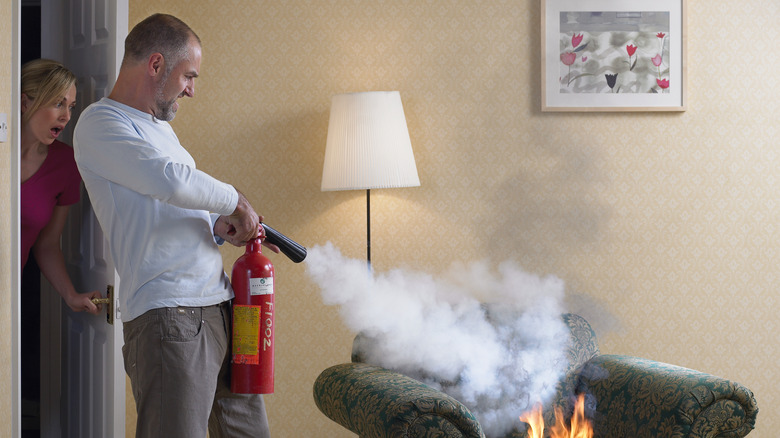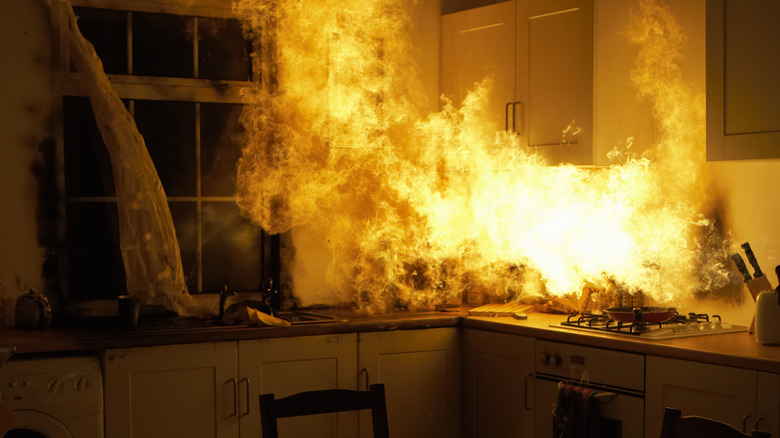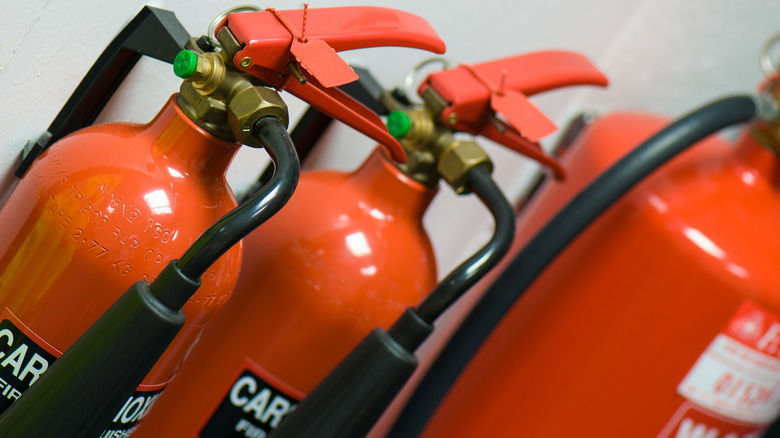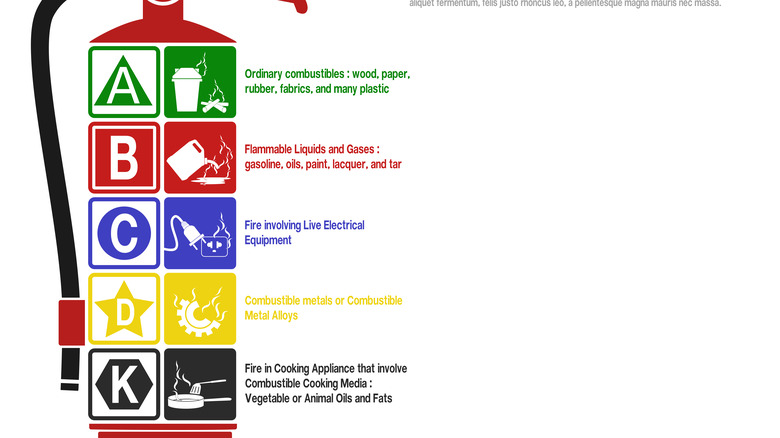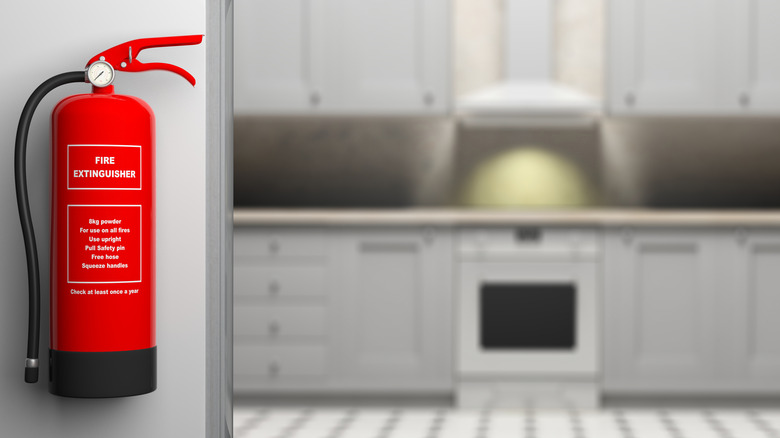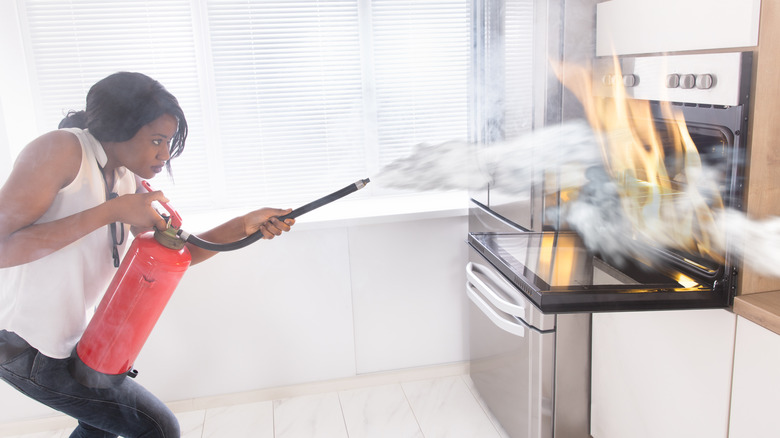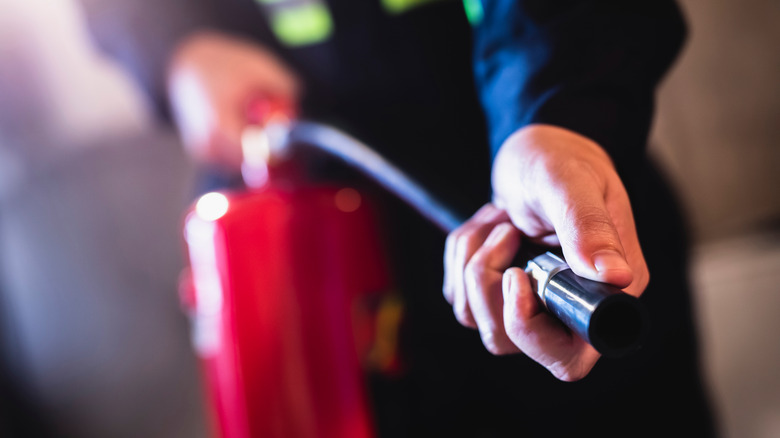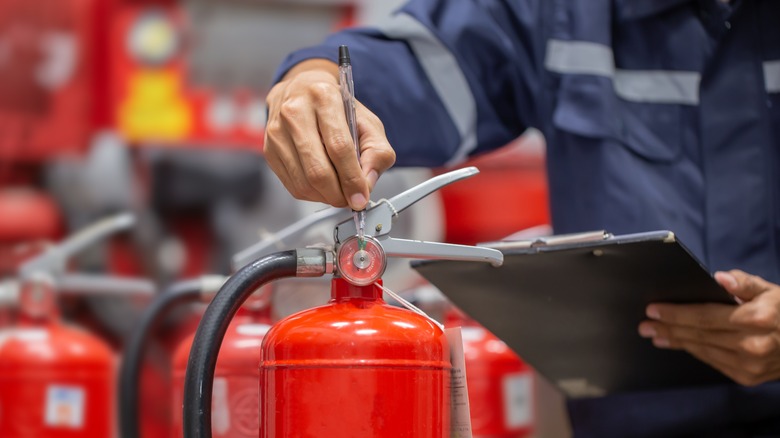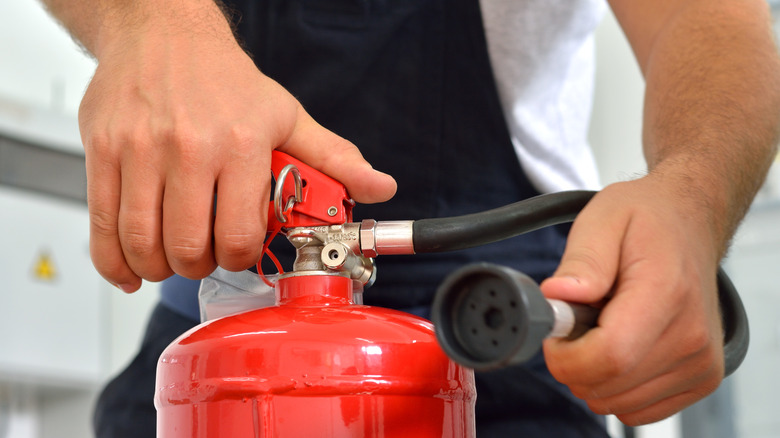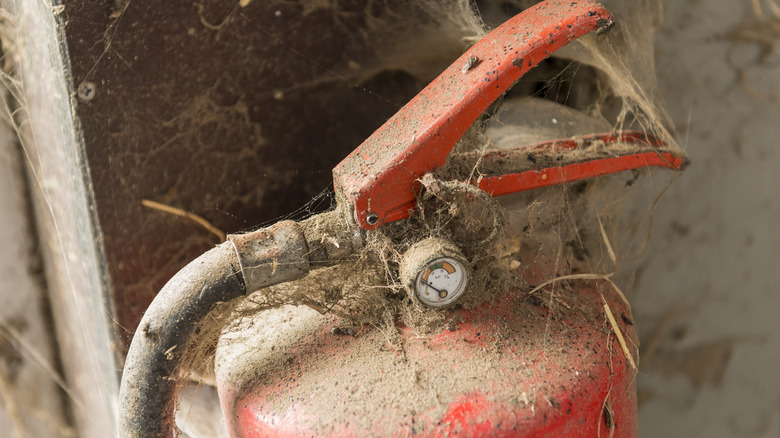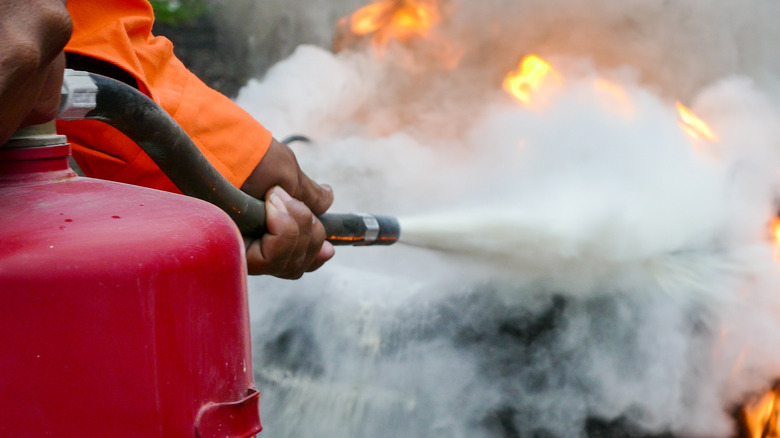What You Need To Know About Buying Fire Extinguishers For Your Home
Home fires can pose a serious threat. According to Ready, it can take fewer than 30 seconds for a small flame to grow into a major fire. Within minutes, the entire house could potentially become filled with hot flames and smoke. There are several steps you can take to protect yourself and the members of your home in the event of a fire. These include installing smoke alarms on each level of the home, creating and practicing a plan to escape the home in the event of a fire, sleeping with bedroom doors closed, and keeping digital copies of important documents.
Another way to make sure you're prepared for the unthinkable is to purchase a fire extinguisher for your home. As the National Fire Protection Agency shares, portable fire extinguishers can help homeowners put out small fires. However, they shouldn't be used until everyone else has safely evacuated the property or if the fire is too large. Before you purchase a fire extinguisher to help keep you and your loved ones safe, there are a few key things to know. Read on to learn more to help you make an informed purchase.
How do fire extinguishers work?
According to Science ABC, before you can understand how a fire extinguisher works, you first need to understand combustion. Combustion is a chemical reaction that occurs when oxygen, heat, and fuel (such as gasoline, paper, or wood) are combined. When these three elements combine, combustion can occur, triggering a fire. Fire extinguishers work to eliminate one of these three essential elements, effectively stopping the process of combustion and putting the fire out.
The contents inside a fire extinguisher's tank are pressurized. This means when the lever is pressed, the contents are released in a fast and heavy burst to smother the flames. The exact formulation of chemicals will vary based on the type of fire extinguisher and the type of fire it is designed to put out. We'll explore both of these concepts in more depth below.
What are the different types of fires?
As Vanguard Fire shares, there are five different classes of fires. These classes vary in the overall fuel type of the fire. Because fire extinguishers are designed to fight specific classes of fires, it is important to understand more about each class of fire.
Class A fires, also referred to as ordinary fires, are the result of paper, wood, trash, and some plastics catching on fire. Class A fires are typically accidental and are the most common fire type. While these fires may be more commonplace, they can also be quite serious. With sufficient fuel, they can spread quickly, leading to serious damage, injuries, or even death.
Fires caused by gasoline, propane, paint, and other flammable liquids are classified as Class B fires. Class C fires are electrical fires. While more likely to occur at construction sites or businesses that use a lot of electrical equipment, Class C fires can even occur with faulty home electronics.
Metallic fires, classified as Class D fires, are more likely to occur in laboratories working with aluminum, magnesium, titanium, and other flammable materials. While they are not very common, they can be very difficult to put out. Like Class B fires, Class K fires are also caused by flammable liquids. However, this class of fires is limited to cooking-related fires, such as grease or oven fires.
What are the different types of fire extinguishers?
Because of the different potential fuel sources for a fire, there must be different types of fire extinguishers to safely put out fires of different classes. The National Fire Protection Agency explains that each type of fire extinguisher uses different agents and materials; some may be suited for use with fires from multiple classes, while others are geared towards one specific fire class.
- Some fire extinguishers use water as the sole or primary extinguishing agent. This type of fire extinguisher is best for Class A fires. However, without any antifreeze, the water inside the canister can freeze in very cold conditions.
- Another type of fire extinguisher is a film-forming foam model. Designed for use with both Class A and Class B fires, this type expels foam to smother the fire.
- Carbon dioxide extinguishers are best for Class B and Class C fires. They don't leave any residue behind, which makes them an ideal choice for businesses with lots of expensive electronics, hospitals, restaurants, and more. To use a carbon dioxide extinguisher, you do need to be closer to the flames to ensure the gas reaches the fire.
- Dry chemical extinguishers can be used to put out Class A and Class B fires. A multipurpose dry chemical extinguisher works to smother the flames, preventing the oxygen in the air from reigniting a fire.
- Wet chemical fire extinguishers are designed for use with Class A and Class K fires. The canisters of these models include a mixture of water, potassium carbonate, potassium acetate, and potassium citrate. With its pH under 9.0, a wet chemical fire extinguisher can smother Class K fires and cool down Class A fires to put them out.
- Finally, dry powder fire extinguishers are specifically designed for use on Class D fires. Sometimes, the special agent used for this type of extinguisher is applied using a shovel or scoop, rather than being sprayed directly on the flames. It is important to consult the application recommendations from each manufacturer.
What do the letters and numbers mean on a fire extinguisher?
According to Guardian Fire Protection Services, the letters and numbers on a fire extinguisher label tell you more about its size, contents, and appropriate uses. Earlier, we shared that there are five classes of fires: A, B, C, D, and K. Each fire extinguisher will include some of these letters, indicating that it is suitable for use on that specific class(es) of fire. For example, an ABC fire extinguisher can be used with Class A, B, and C fires. ABC fire extinguishers are the recommended type for most homes and businesses, as Class A, B, and C fires are the most common in these locations.
In addition to the letters on the extinguisher, you'll also find numbers. These numbers share information about the extinguishing agent's size ratings. Senior Safety Advice shares that a 2A:10B:C rating is the most common for models designed for use in a home. The A in this rating stands for water equivalency. Since A has a value of 1 ¼ gallons of water, a 2A fire extinguisher would have the equivalence of two and a half gallons of water, or more than 20 pounds of water.
The B in the rating indicates the number of square feet that the fire extinguisher should be able to handle. A fire extinguisher with a 10B rating will be suited for rooms of 10 square feet or less, while a 20B model will be able to handle larger spaces of up to 20 square feet.
The letter C at the end of the rating does not have to do with size. Rather, it tells more information about the type of fire the extinguisher can be used on. Models with a letter C can be used on electrical fires because they do not contain any conductive agents.
Where should I keep a fire extinguisher in my home?
As Impact Fire shares, it doesn't take long for a small flame to grow into an uncontrollable fire. Keeping your fire extinguisher(s) within easy access can keep the flames from spreading, helping to protect your home and the people inside of it. There are five key areas in the home where you should consider storing a fire extinguisher.
One of the most important places to keep a fire extinguisher is in the kitchen. Many home fires originate from cooking in the kitchen, so keeping a fire extinguisher close by can help prevent a tragedy. Aim to keep your fire extinguisher no further than 30 feet away from your stove and oven, without it being so close that it could get blocked by flames or smoke from an oven fire.
If you have a fireplace, pellet stove, space heater, or any other type of heating equipment, this is another important place to keep a fire extinguisher. Place the extinguisher close to the equipment — but not too close. You should also consider keeping a fire extinguisher in your garage, particularly if you store fuel there or work with power tools.
Making sure you have at least one fire extinguisher on each floor of your home can help save precious time and allow you to act quickly in the event of an emergency. Many fires occur after everyone in the house is asleep, so keeping a fire extinguisher in each bedroom can also help make sure you are prepared.
Once you've placed the fire extinguisher(s) in your home, be sure they remain visible and accessible. You should also share their location with everyone else living in the home so that they are also prepared.
When should you use a fire extinguisher?
While you may think that you should reach for a fire extinguisher any time you see flames, it isn't that simple. The University of Rochester shares how the acronym RACE can help you decide when or if you should try to use a fire extinguisher to put out a fire. The first letter in the acronym, R, stands for rescue. Before attempting to put out flames, you should begin by rescuing any individuals in the path of danger and helping them get to a safe location.
A stands for activate. After pulling the fire alarm (if there is one), call 911 for help to get the fire department on their way. Next is C, to confine the fire and stop it from spreading. To do so, close the doors to the room where it is.
Next is the letter E, which may stand for evacuate or extinguish. If you don't feel comfortable trying to use the fire extinguisher, the fire is spreading too much, or you are afraid that the fire may end up blocking your exit route from the room, evacuate the building right away. If you feel confident in using a fire extinguisher, the flames are not too large or out of control, and the exit route from the building remains clear, then you can extinguish the fire using the fire extinguisher.
How do you use a fire extinguisher?
As mentioned above, you shouldn't try to use a fire extinguisher if you're not confident in doing so. According to SafeWise, before trying to use the fire extinguisher, look for a clear exit route. This will allow you to be prepared in case the fire extinguisher is not able to put out the flames or you decide that you are uncomfortable trying to use it.
Once you have an evacuation route planned out, grab the fire extinguisher and stand between 6 and 8 feet from the fire. Remember the acronym PASS to help you operate the extinguisher. Start by pulling the pin (P), then aim the nozzle at the base of the flames (A). Discharge the contents of the tank by squeezing the lever (S) and then sweep the nozzle side to side as you extinguish the flames (S). As you work to extinguish the fire, you should keep the nozzle pointed at the base of the fire. Continue sweeping back and forth until the fire is put out.
After you have extinguished the fire, continue to watch the area. It is possible for the flames to reignite, in which case you'll want to aim the nozzle at the base of the flames and sweep back and forth again. If no one has alerted the fire department, you should contact them now as well. They'll arrive to perform an inspection of the cause of the fire and confirm that it is out completely and that there is no risk of reignition. Finally, move yourself to a safe outdoor location to wait for the fire department.
What do you need to do to maintain a fire extinguisher?
If there ever is a fire, you want your fire extinguisher functioning and ready to help you put out the flames. The National Fire Protection Agency explains the importance of following inspection, testing, and maintenance protocols to ensure that fire extinguishers are ready to use as needed. Fire extinguishers should be inspected once a month. This can be performed by any individual, as no special certifications are needed. An inspection should include confirming the extinguisher is where it belongs, easily visible, and easily accessible. Check the pressure gauge to confirm it is in the correct range, and lift or weigh the extinguisher to make sure that it is still full.
Ideally, a certified person should conduct a yearly external maintenance examination on fire extinguishers. Internal examinations should also be conducted, but their recommended frequency can vary based on the extinguisher type and the manufacturer's recommendations (some should be looked at once a year, while some are only required to be examined every 6 years).
Finally, hydrostatic testing should be performed every 5 or 12 years, depending on the type of extinguisher and the manufacturer's recommendations. This testing checks for leaks and other potential problems and must also be performed by a qualified and certified person or company.
Can fire extinguishers be refilled?
Some fire extinguishers can be refilled or recharged, while others cannot. According to First Alert, non-rechargeable fire extinguishers must be disposed of and replaced after every use. These models are only designed for a single use, and will not work again to extinguish a future fire because the pressure decreases after use.
On the other hand, rechargeable fire extinguishers can be used multiple times. After each use, or if the pressure decreases between uses, these models should be refilled by a certified company. Impact Fire notes that even if just a small portion of the contents were discharged, recharging is still essential. Otherwise, it is likely that the contents will slowly leak, decreasing the pressure of the canister, which could render the extinguisher useless to fight a future fire.
When a fire extinguisher is recharged, a certified individual empties its contents and disassembles parts of the unit. It is then cleaned, given a new valve stem, and refilled with the right type and amount of extinguishing agent. Then, the technician repressurizes the unit, checks for leaks, and confirms the weight.
How do you dispose of an old fire extinguisher?
CNET shares that fire extinguishers last 10 to 12 years, on average, before you'll need to replace it. However, if the unit or any of its components are damaged, it may need to be disposed of and replaced sooner. Storing fire extinguishers in very hot or very cold temperatures (above 120 degrees Fahrenheit or below 40 degrees Fahrenheit) can also decrease their lifespan, making it necessary to replace your unit. Other signs that it may be time to dispose of a fire extinguisher include corrosion, a cracked hose, loss of pressure over time, and a wiggly handle.
According to Fire Systems Inc., you cannot simply throw out or recycle a fire extinguisher unless it is empty. The extinguishing agents in their canisters are considered hazardous waste. This means that they are not safe to throw out with your regular trash. If your extinguisher is full, you can bring it to a local hazardous waste facility. Depending on where you live, your local fire department may also take old extinguishers and dispose of them properly for you.
What are the risks of using a fire extinguisher?
Fire extinguishers can be an incredibly valuable tool in protecting people and property from the destruction that fires can cause. However, their use doesn't come without risks. As Spectrum Fire Protection shares, it is very important to make sure you are using the right type of fire extinguisher for the specific type of fire you're trying to put out. The wrong extinguishing agent could make things worse, such as trying to use a water- or liquid-filled extinguisher to put out an electrical fire.
Service Fire Equipment explains that there are also some risks associated with the chemicals used to fill fire extinguishers. While they are non-toxic and designed to be safe to use in homes and buildings, they can still cause some minor problems, such as skin irritation. After discharging a fire extinguisher, wear gloves to clean up the residue.
It should go without saying, but the powder or foam that comes out of a fire extinguisher is not designed for consumption. While you'd likely never try to purposefully ingest the power, it may be present on cookware or dishes if the fire extinguisher was used in a kitchen. After using a fire extinguisher, inspect the area around the site and wash any items that may have gotten sprayed.
Inhaling the powder from a fire extinguisher can also be quite dangerous, though the level of dust in the air usually isn't high enough to be of concern with smaller home extinguishers. If too much powder is inhaled, it can coat the inside of the lungs and cause breathing problems. If you used a fire extinguisher and are worried you inhaled too much of the powder, seek immediate medical attention.
